Rice paper rolls are also known as rainbow rolls or summer rolls. They are a popular dish in Vietnamese cuisine. Rice paper wrappers filled with fresh, crisp veg, aromatic herbs, noodles and a protein. In this recipe, I've chosen to use tofu. We eat these rolls at room temperature or chilled, with a dipping sauce.
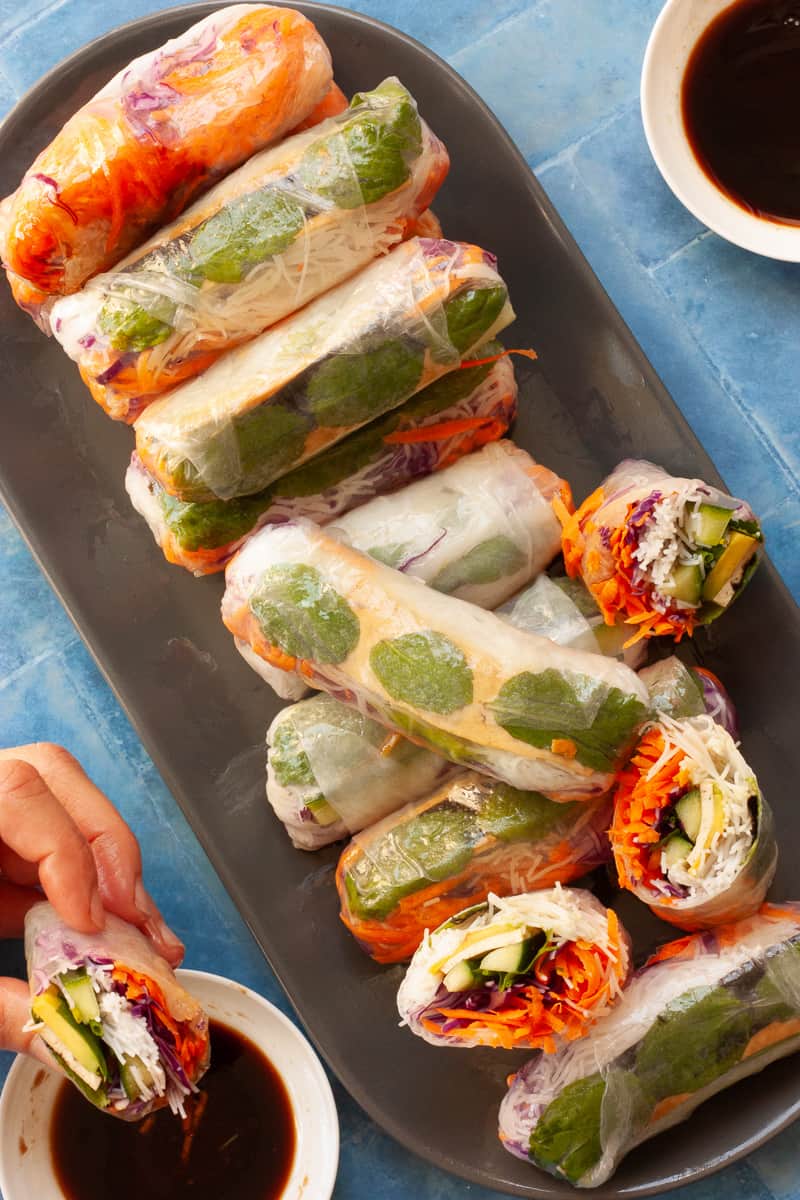
These rice paper rolls are:
- low FODMAP, vegan and gluten-free. No 'weird' substitutions, or alterations; they just are.
- light, fresh and versatile
- great nibble or light meal option
- good to last a day or two in the fridge (but will taste best eaten on the day of rolling).
You'll get 16 rice paper rolls with this recipe, enough to serve 4-8 people.
🥘 Ingredients
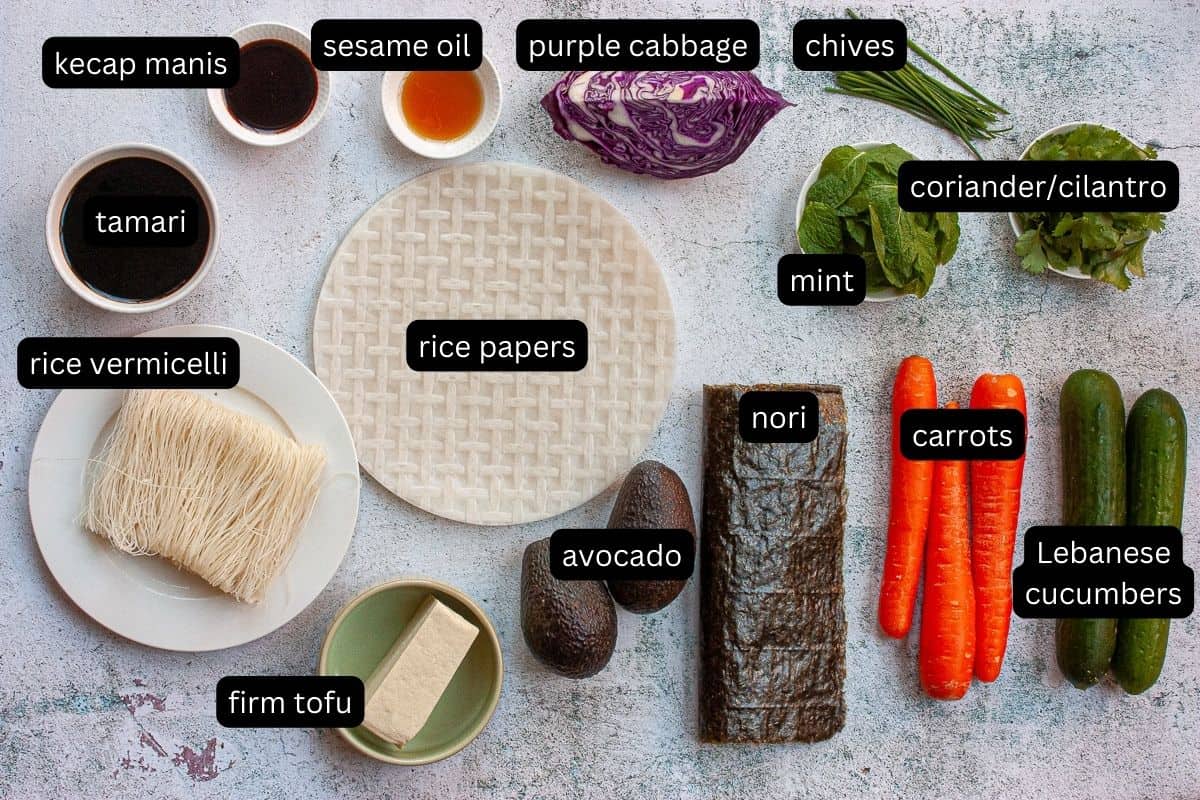
Firm Tofu - usually comes in blocks of around 400g - way more than what you need for this recipe. You can keep the remaining tofu in water in the fridge and eat it in chunks tossed into salads over the next few days. I've heard that frozen tofu gets extra chewy after (which I don't think is a bad thing). I haven't got around to trying to freeze it yet. Next time! I plan to try freezing it in 100g portions, defrosting it overnight in the fridge and slicing as per the recipe. I'll update this recipe with my findings. Let me know in the comments if you've tried freezing tofu.
Rice Vermicelli - vermicelli means 'little worms' in Italian. Don't ask me why you find them in the Asian aisle in the supermarket. They're very thin white noodles made with rice flour and water. It comes dried in compressed bundles and cooks quickly - a few minutes in hot water. Make sure you buy the rice vermicelli. There is also vermicelli made with other ingredients, such as mung beans.
Make sure you buy the rice vermicelli.
Gluten-Free Tamari - we use this twice in the recipe, in the tofu marinade and the dipping sauce. Gluten-free tamari is a version of soy sauce that doesn't contain wheat. This is important if you need this to be gluten free. Be sure to check that it says 'gluten-free' on the packaging; not ALL tamari is gluten-free. If this isn't important, use standard soy sauce instead.
Kecap Manis - sweet and thick Indonesian soy sauce used as a condiment in various dishes. Like the tamari, find a gluten-free brand if you need to.
Nori - the same stuff that we use to wrap sushi hand rolls in. Dried seaweed sold in thin sheets. You'll need less than one sheet for this recipe, a thin strip for each rice paper roll.
Chives- provide a subtle onion flavour without the FODMAPs that spring onions/scallions have. They look good and are easy to use because they need little prep.
Bright, Crunchy Veg - carrots, purple cabbage and cucumbers. Use two of the smaller Lebanese variety or half an English one.
Fresh Herbs - coriander and mint leaves.
Rice Papers - these are round dry sheets about the size of a dinner plate, made with rice flour. They soften quickly and easily in a little cold water and are used to wrap the fillings.
Are rice paper rolls low FODMAP?
*Yes. As always, it's hardly ever a firm 'yes' or 'no' when it comes to whether recipes contain any FODMAPs. You can enjoy these rice paper rolls as part of the initial elimination low FODMAP diet.
If you're interested, I've separated the ingredients into two categories below.
You can eat the 'FODMAP-free' ingredients with abandon. The 'low FODMAP' ingredients listed below are within 'acceptable' limits with two caveats. You use the suggested weights listed in the recipe card and eat no more than four rolls in a serving.
FODMAP-free - rice vermicelli, nori, carrots, chives, mint leaves, coriander leaves, rice papers, sesame oil.
Low FODMAP (*if you stick to a serving size of no more than 4 rice paper rolls). Firm tofu, tamari, kecap manis, cucumber, red cabbage and avocado.
I use the Monash app to verify the FODMAP status of my recipes.
🔪 Instructions
Set yourself up for success
Get all your ingredients prepped first and close to hand. You'll get into a groove of assembling and won't want to stop to prep stuff or get more. It's handy to have a second (dry) tea towel to hand for wiping your hands clean between making each roll.
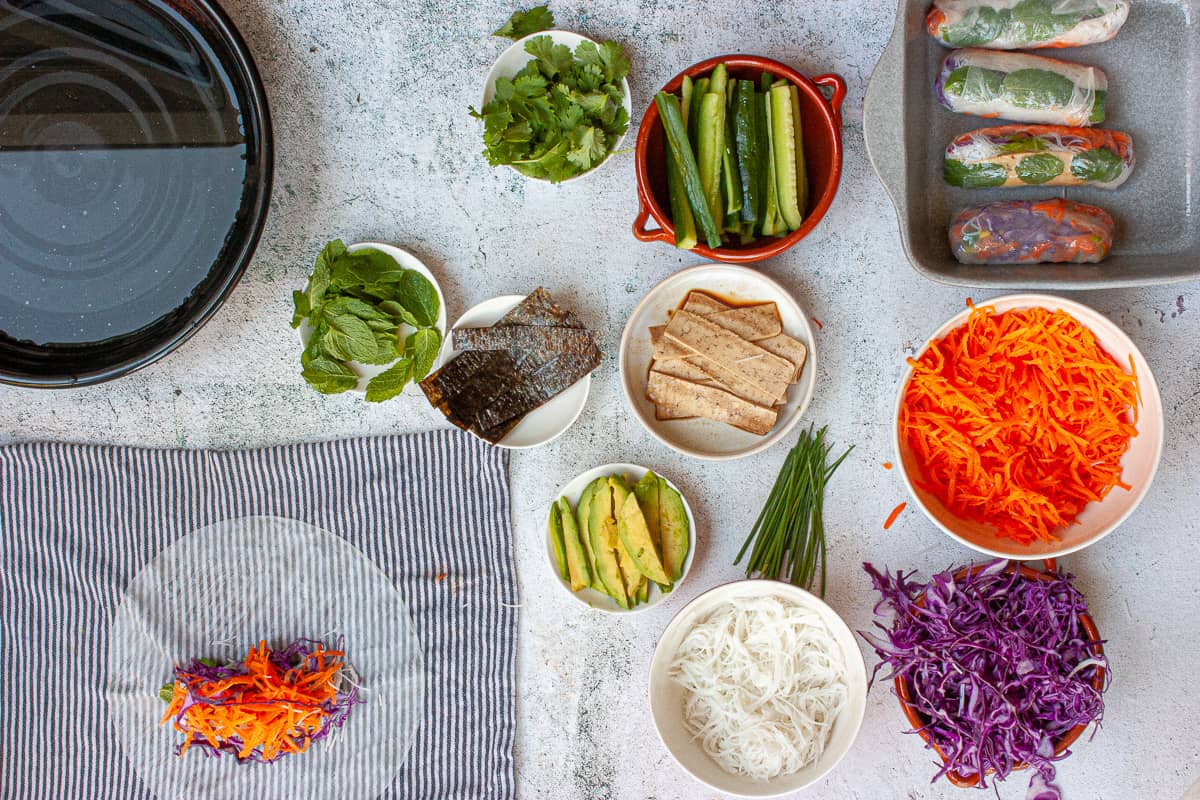
How to soften a rice paper
Dip paper one at a time in water for about 3 seconds, then transfer to a damp tea towel. If the towel is dry, the rice paper will stick to it like a second skin.
Don't worry if the rice paper still seems a bit hard when you start rolling - harder than you'd want to eat. It will continue to soften.
It's easier to roll when it's on the firm side. Don't dip in the water too long. It will end up with the consistency of plastic wrap and be a nightmare to handle!
What order do you fill a rice paper roll?
It doesn't really matter what order you lay your ingredients on the rice paper. I tend to lay the mint leaves prettier side down first in a row, because they look nice on the outside of the rolls. For the same reason, I put the purple cabbage or carrot down last. It's up to you! I find it easier to go through the fillings in the order they are laid out in front of me so that I don't miss any out. I also count as I go along; muttering along like a woman possessed! There are ten fillings 😆
How do you roll a rice paper roll?
See the photo collage below.
- pile up fillings just below the centre of the rice round (photo 1).
- lift the rice paper from closest to you to cover the fillings (2).
- bring the sides in one at a time towards the centre (3 and 4).
- roll up away from you (like rolling up a burrito) (5 and 6).
Don't worry if the rice paper gets too soft by the time you've finished piling up your fillings and sticks to the tea towel. The rice paper is surprisingly strong. You can usually prise it away without tearing it. A slight grip on the tea towel makes it easier to get a tight roll, that's why we use it. Make sure your tea towel is clean and lint-free.
Very important! Spray the finished rolls (and wherever you're putting them) all over with a neutral vegetable oil spray. This way they won't stick to each other and tear.
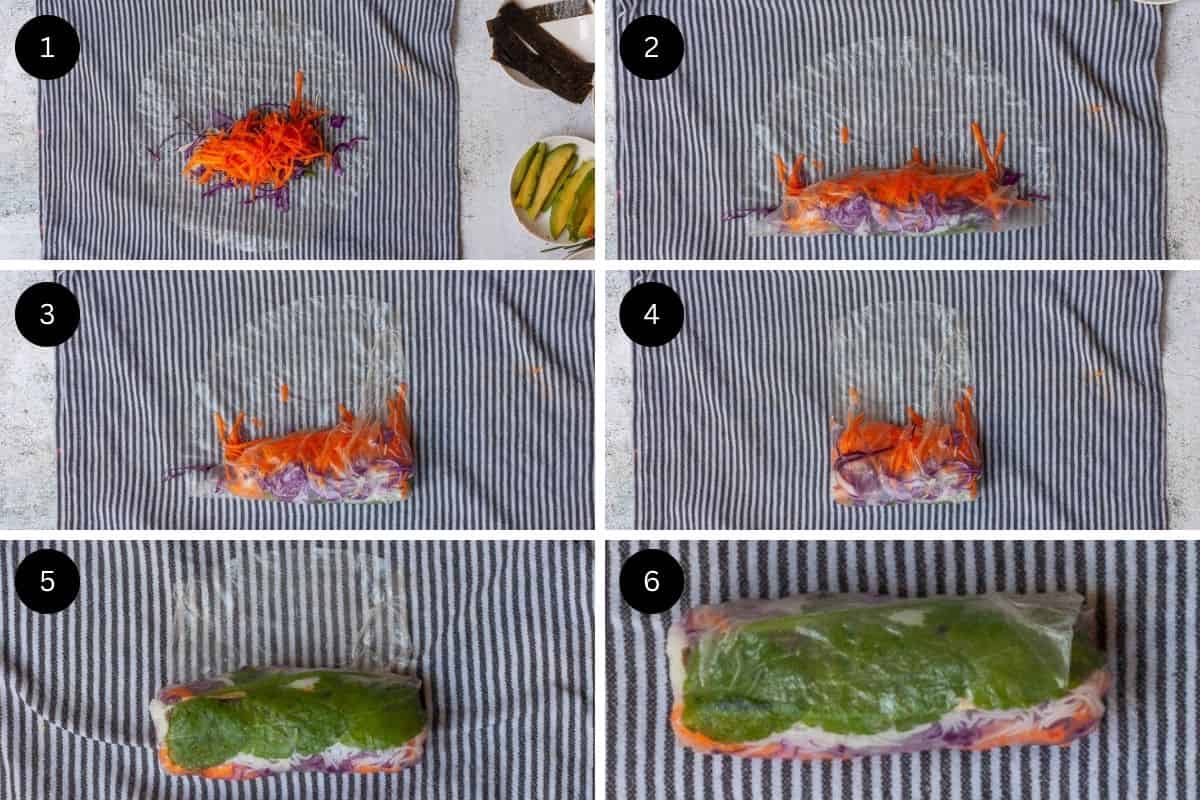
Provide little individual bowls for dipping - you'll want to double-dip! Allow around two teaspoons of dipping sauce per roll.
📖 Recipe
Ingredients
Rice Paper Rolls
- 60 g dry vermicelli
- 100 g firm tofu
- 2 Tablespoons tamari
- Tablespoon kecap manis
- 1 sheet nori
- 3 carrots
- 2 Lebanese cucumbers
- 5 g chives
- 160 g purple cabbage
- 1 avocado
- approx. 50 small mint leaves
- approx. 50 small coriander leaves
- packet rice papers (usually contains 16 wrappers)
Dipping Sauce
- 160 g/ml tamari
- 2 teaspoons sesame oil
Instructions
Prep Fillings
- Noodles - pour boiling water over the vermicelli. Make sure all the noodles are under the surface of the water. Allow to soften for a couple of minutes before draining and rinsing. Use kitchen scissors to cut into smaller lengths. This makes it easier to portion between the rice paper rolls. There's no need to cut to any particular length.60 g dry vermicelli
- Tofu - cut into 16 strips, each about a finger in length, about 2-3 mm thick.100 g firm tofu
- Tofu Marinade - combine two tablespoons tamari and kecap manis in a small bowl. Gently lay each of the tofu strips in this, coating both sides. Lift out and set aside.2 Tablespoons tamariTablespoon kecap manis
- Nori - cut into strips about the same size as the tofu (scissors are good for this). Try to keep the nori dry (it gets sticky and hard to handle when damp).1 sheet nori
- Carrot - coarsely grate.3 carrots
- Cucumbers - cut in half to get two shorter sections. Cut each of these in half to open. Use a teaspoon to scoop out and discard the seeds. Cut into 32 matchsticks (so that we end up with two per roll).2 Lebanese cucumbers
- Chives - cut in finger-lengths. We want 32 strips in total (2 for each roll).5 g chives
- Cabbage - very finely shred/use a mandoline.160 g purple cabbage
- Avocado - cut into 16 strips about a finger long (one per roll).1 avocado
- Fresh Herbs - pinch off about 50 leaves of each, leaving any fibrous stems behind.approx. 50 small mint leavesapprox. 50 small coriander leaves
Roll! Fillings Ready - have all your (ten) fillings laid out in front of you. These are - noodles, cucumbers, carrot, mint, coriander, tofu, chives, cabbage, avocado and nori.
- Dipping Receptacle - have a container big enough to lay a rice paper sheet flat ready with a little cold water in it.
- Damp Tea Towel - wet a clean tea towel and wring it out so that it is damp, not dripping wet.
- Briefly Dip - put one rice paper in water for about 3 seconds. Enough time to wet it all over and no longer. Then lay on the damp tea towel. Don't worry if the rice paper still seems a bit hard - harder than you'd want to eat. It will continue to soften. It's easier to roll when it's on the firm side.packet rice papers
- Pile Fillings - it doesn't really matter what order you lay your ingredients on the rice paper. Place them in a stack just below the centre of the roll with a strip of bare roll on either side. I tend to lay the mint leaves prettier side down first in a row, just because they look nice on the outside of the rolls. For the same reason, I put the purple cabbage or carrot down last. It's up to you!
- Roll Up - lift the rice paper from closest to you to cover the fillings. Bring the sides in one at a time towards the centre. Roll up away from you (like rolling up a burrito). Don't worry if the rice paper gets too soft by the time you've finished piling up your fillings and sticks to the tea towel. The rice paper is surprisingly strong. You can prise it free without tearing. A slight grip on the tea towel makes it easier to get a tight roll, that's why we use it.
- Oil - Very important!! Spray the finished rolls and wherever you're putting them all over with a neutral vegetable oil spray. This way they won't stick to each other and tear.
- Dipping Sauce - combine tamari and sesame oil in a bowl.160 g/ml tamari2 teaspoons sesame oil


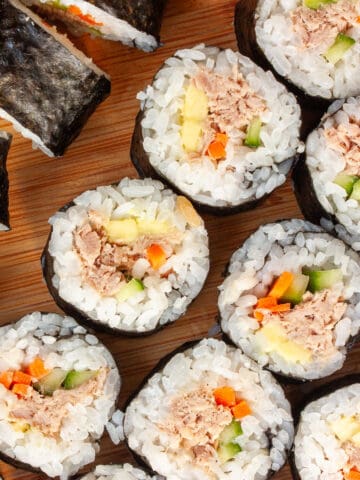
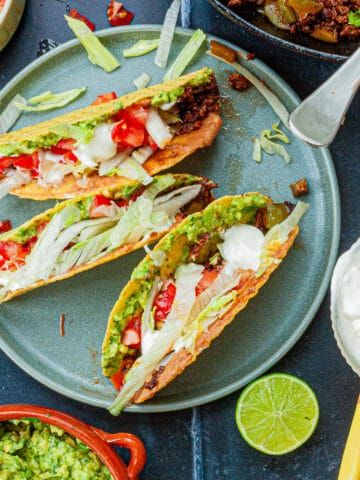

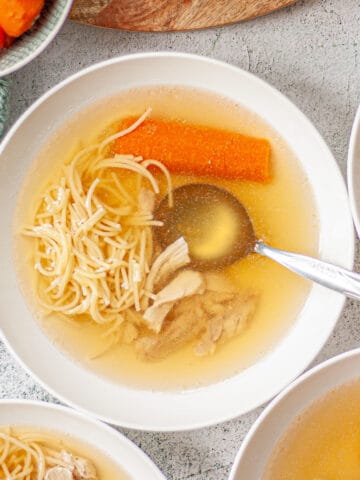

Comments